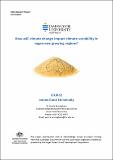| Author | Everingham, Y |
| Date Accessioned | 2015-03-11 |
| Date Available | 2015-03-11 |
| Issued | 2012 |
| Identifier | http://hdl.handle.net/11079/13999 |
| Abstract | Sugarcane is the fastest growing, largest biomass and highest sucrose accumulated agricultural crop today
that offers a valuable contribution to delivering a sustainable future (Skocaj, 2013). Aside from cereal crops,
sugarcane is the largest contributor of carbohydrates for human consumption and the conversion of
sugarcane to raw sugar produces a wide variety of important by-products such as bioenergy, biofuels,
bioplastics, paper, animal feed and synthetic fertilizers. Climate is a key driver of sugarcane production and
its by-products. Given the significant contribution sugarcane production systems make to economic growth
and development, especially in poor countries where sugarcane contributes to the economy, it is critical to
understand how this production system will be impacted by climate change. |
| Abstract | The project team worked closely with researchers from Australia’s Bureau of Meteorology and the CSIRO to
investigate the impact climate change will have on productivity and harvest practices. The productivity
study was undertaken in three regions – Burdekin, Mackay and NSW, and the harvest study in seven
regions – Tully, Herbert, Burdekin, Mackay, Bundaberg, Rocky Point and NSW. The project team assessed
the change in projected climate across the industry on a grid as small as 5 km by 5 km. A small grid is very
important when topography changes rapidly. This is pertinent to Australia’s sugarcane-growing regions that
are wedged between high mountain ranges and the flat eastern coastline. This type of geography has an
enormous affect on local climate patterns which are difficult to detect using coarse resolution projections.
Further, our yield projections relied heavily on new project findings from a state-of-the-art glass house
experiment (Project: CPI018) that grew sugarcane plants in a future climate with higher CO2 levels. These
projections were compared against the baseline period 1961 to 2000. Projections considered two climate
scenarios B1 and A2. The latter scenario represents a future with a lower technological change, higher
population growth and higher emission of greenhouse gases like carbon dioxide than the B1 scenario. To
communicate our findings in a simple manner that maintained investigative rigour, the project team
developed an original robust statistical procedure that differentiates between ‘plausible’ and ‘highly
plausible’ system changes. |
| Abstract | Based on our modelling design, yield projections recognised an increase was plausible for the Burdekin and
Mackay under the B1 scenario and highly plausible for NSW under the A2 scenario. This is an important
result as recent climate change research suggests the higher emissions future is more likely and modelled
outputs for this scenario do not support a plausible increase in yields for Burdekin and Mackay. Under a
high emissions future (A2) it is plausible for industry to plan for more harvest disruption in spring (Ingham)
and less harvest disruptions in winter and spring (Burdekin) and winter in Bundaberg. Under a low emission
future it is plausible for industry to plan for more harvestable days in winter (NSW). These changes were
deemed subtle e.g. the change in the simulated number of unharvestable days averaged across the
downscaled GCMs was typically less than a few days. However there were some regions (Tully, Bundaberg,
Rocky Point and NSW) where individual models projected an increase of 5 to 21 unharvestable days which
would have a dramatic effect on harvest operations, especially if yields were to increase along with pre harvest (autumn) rainfall. Harvestability projections should be considered closely with yield projections and
rainfall projections either side of the harvest window. Spatial projections revealed changes within a region
are not always uniform and adaptation strategies may need to vary within a region. |
| Abstract | Given the challenges of delivering sustainable solutions to feeding, fuelling and employing a society where
growth and development are on the rise, it is timely and critical to understand the impact climate change
will have on sugarcane industries across the globe. In the face of competing solutions and finite resources,
the findings from this project can assist policy makers not only in Australia but around the world with
developing robust adaptation strategies that minimise risk and maximize opportunities in response to the
challenges associated with a changing climate. |
| Language | en |
| Publisher | SRDC |
| Part of Series | Internal Report; 2012 JCU032 |
| Subject | Climate variability |
| Subject | Climate change |
| Subject | Modelling |
| Subject | Modelling |
| Subject | Harvest disruptions |
| Subject | Adaptation strategies |
| Subject | Rainfall projections |
| Subject | Sustainability |
| Subject | Temperature projections |
| Subject | Regional climate data |
| Subject | Projected change |
| Subject | Radiation changes |
| Subject | Atmospheric variables |
| Subject | Farming systems |
| Subject | Production management |
| Title | How will climate change impact climate variability in sugarcane growing regions? : SRDC Final report JCU032 |

